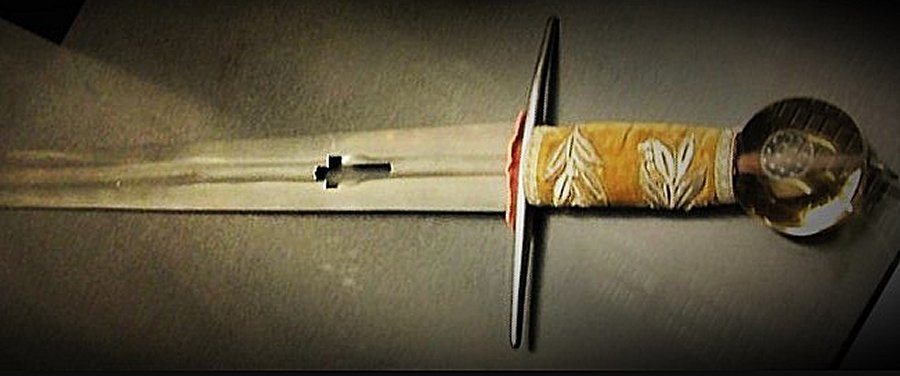Prince Wenceslaus Of Bohemia Murdered On Order Of His Own Brother
Angela Sutherland - AncientPages.com - The Sword of Saint Wenceslas, also known as the Coronation Sword of Bohemia, has its beginnings in the Kingdom of Bohemia, and it tells the tragic story of two brothers.
 The iron blade is 76 cm long, at the widest point is 45 mm and has a ripped hole in a cross shape (45 x 20 mm). The wooden handle is covered with brown-yellow fabric, embroidered with the ornament of laurel twigs with thick silver thread. The cross on the blade was most likely made later in the Middle Ages. Source
The iron blade is 76 cm long, at the widest point is 45 mm and has a ripped hole in a cross shape (45 x 20 mm). The wooden handle is covered with brown-yellow fabric, embroidered with the ornament of laurel twigs with thick silver thread. The cross on the blade was most likely made later in the Middle Ages. Source
The relic is a ceremonial sword with a blade whose age and history go back to the 10th century, to the times of St. Wenceslaus, the Duke of Bohemia, from 921 until his assassination in 935.
Wenceslaus (Polish: Waclaw) was born in 907 in Stochov and was Duke of Bohemia, a medieval and early modern monarchy in Central Europe. He was the son of Prince Vratislav and the pagan princess Drahomira, the daughter of a Veletian chieftain.
The Veletians were a Baltic Slavic tribe known as fierce or wild ('Ljutici') for their long and violent resistance to Christianity. It is rather curious that Drahomira was given in marriage to the Christian ruler of Prague.
 Left: Prince of Bohemia, Wenceslaus; Right: Wenceslaus, probably by Peter Parler, in St. Vitus Cathedral, Prague. (Public Domain)
Left: Prince of Bohemia, Wenceslaus; Right: Wenceslaus, probably by Peter Parler, in St. Vitus Cathedral, Prague. (Public Domain)
St. Wenceslaus was a Czech prince from the Przemyslid dynasty. This royal dynasty reigned in the Duchy of Bohemia and later the Kingdom of Bohemia and Margraviate of Moravia (from the 9th century to 1306 AD) and parts of Poland (including Silesia), Hungary, and Austria.
When Wenceslaus was thirteen, his father, Vratislav, died, and the government and two boys (Wenceslaus and Boleslaus) were entrusted to their grandmother, Ludmila of Bohemia.
However, there is conflicting information about whether Ludmila raised one or two boys. Some sources say that the boys' mother, Drahomira raised Boleslaus while Ludmila devoted her attention to Wenceslaus.
Pagan And Christian Tensions In The Family Of Wenceslaus
Ludmila taught Wenceslaus the Christian faith and was determined that Wenceslaus would do two things in his life. At first, he needs to become a Christian, and second, rule his country instead of his pagan mother.
In the opinion of the Czech chronicler Cosmas of Prague, Drahomira remained a pagan even while living among the Czechs. It gave rise to the devastating conflict between the daughter-in-law and mother-in-law. Why did a devoted pagan such as Drahomira marry a Christian ruler? How could the church allow this union? Did Drahomira have a hidden agenda?
In the opinion of the Czech chronicler Cosmas of Prague (c.?1045 –1125), Drahomira remained a pagan even while living among the Czechs.
Wenceslaus I Killed On Order Of His Brother
Shortly after the kingdom's rule was passed to the young prince Wenceslaus, Ludmila was strangled on September 15, 921, most likely by Drahomira, who hired assassins.
 Wenceslaus' assassination: the duke flees from his brother (with sword) to a church, but the priest closes the door. Gumpold von Mantua, 10th century) Public Domain
Wenceslaus' assassination: the duke flees from his brother (with sword) to a church, but the priest closes the door. Gumpold von Mantua, 10th century) Public Domain
Hatred, rivalry, and jealousy are destructive feelings that often destroy families. Drahomira, the brothers' mother, arranged to have Ludmila killed.
Wenceslaus banished his pagan mother and Boleslaus, starting the process of consolidating the Christianization of Bohemia.
Still, some of the powerful noblemen supported the banished Boleslaus, and they formed an opposition. They grew angry because a Christian king ruled the Kingdom of Bohemia.
On September 28, 935 AD, Boleslaus invited his brother to the ceremony honoring two saints, Cosmas and Damian (in Roman: Kuzmas and Dimyan), twin brothers and physicians from the Cilicia region, Asia Minor. These physicians practiced curing patients, especially the poor ones, without charging any fees for their treatment. In this way, they also attracted many people to the Christian faith. The brothers became early Christian martyrs.
During the Cosmas and Damian feast, a quarrel broke out between Wenceslaus and Boleslaus of Bohemia. The latter grabbed his dagger, and Wenceslaus escaped to the church. Unfortunately, before he arrived, three knights of his younger brother killed him at the chapel door.
Wenceslaus was murdered precisely when a son of Boleslaus was born. The child was given a bizarre name: 'Strachkvas,' which means "a dreadful feast."
In the iconography, Wenceslaus is depicted in armor and a royal costume. His attributes are a dagger - the tool of his death, an angel giving him a spear and a coffin carried by angels.
Before Wenceslaus died, he asked God's mercy for his brother, and thus he was recognized as a martyr. He was declared patron of Bohemia, now the Czech Republic.
Many legends described his life and martyrdom, including the "First Old Slavonic Legend" that originated in the tenth century.
Wenceslaus means in Slavic' great glory'.
Written by – A. Sutherland - AncientPages.com Senior Staff Writer
Updated on May 25, 2023
Copyright © AncientPages.com All rights reserved. This material may not be published, broadcast, rewritten or redistributed in whole or part without the express written permission of AncientPages.com
Expand for referencesReferences:
BORON Piotr, Kniaziowie, królowie, carowie
Ingham, Norman W. "Structure as Meaning in the "First Slavonic Life of St. Wenceslas"." Harvard Ukrainian Studies 28, no. 1/4 (2006)
Alban Butler A., Burns P. Butler's Lives of the Saints
Lusk Steven R. Descendants of Godwulf
More From Ancient Pages
-
 Mystery Of The 2,000-Year-Old ‘Urn Burial’ Ceremonies: 113 Tombs Discovered Near the Ancient City Of Fudi
Archaeology | Oct 11, 2016
Mystery Of The 2,000-Year-Old ‘Urn Burial’ Ceremonies: 113 Tombs Discovered Near the Ancient City Of Fudi
Archaeology | Oct 11, 2016 -
 On This Day In History: 4000 Defenders Of Pilėnai Commit Mass Suicide When Attacked By Teutonic Knights – On Feb 25, 1336
News | Feb 25, 2017
On This Day In History: 4000 Defenders Of Pilėnai Commit Mass Suicide When Attacked By Teutonic Knights – On Feb 25, 1336
News | Feb 25, 2017 -
 Unusual Ancient Winged Half-Human And Half-Animal Divine Creature With Supernatural Powers
Artifacts | Jul 30, 2019
Unusual Ancient Winged Half-Human And Half-Animal Divine Creature With Supernatural Powers
Artifacts | Jul 30, 2019 -
 Emerald Mound In The Ancient City Of Natchez: Second Largest Temple Mound In North America
Featured Stories | Feb 22, 2018
Emerald Mound In The Ancient City Of Natchez: Second Largest Temple Mound In North America
Featured Stories | Feb 22, 2018 -
 Hel – Loki’s Terrible Daughter And Goddess Of The Land Of Dead
Featured Stories | Mar 26, 2018
Hel – Loki’s Terrible Daughter And Goddess Of The Land Of Dead
Featured Stories | Mar 26, 2018 -
 Calçoene – Amazon Stonehenge And The Mysterious Amapán Megalithic Culture
Civilizations | Feb 14, 2018
Calçoene – Amazon Stonehenge And The Mysterious Amapán Megalithic Culture
Civilizations | Feb 14, 2018 -
 Human Footprints Dating Back 800,000 Years Discovered In Norfolk UK
Archaeology | Feb 7, 2014
Human Footprints Dating Back 800,000 Years Discovered In Norfolk UK
Archaeology | Feb 7, 2014 -
 Yenikapı Excavations Reveal 8,500-Year-Old Artifacts
Archaeology | Jan 10, 2016
Yenikapı Excavations Reveal 8,500-Year-Old Artifacts
Archaeology | Jan 10, 2016 -
 Ten Inscriptions Related To Sargon Unearthed At Ancient Assyrian Site In Iraq’s Kurdistan Region
Archaeology | Jan 20, 2020
Ten Inscriptions Related To Sargon Unearthed At Ancient Assyrian Site In Iraq’s Kurdistan Region
Archaeology | Jan 20, 2020 -
 Mystery Of The Lost Underground City Of The Grand Canyon
Featured Stories | Nov 19, 2014
Mystery Of The Lost Underground City Of The Grand Canyon
Featured Stories | Nov 19, 2014 -
 Excavations Of Ancient Theater In 2,400-Year-Old City Of Smyrna, Turkey
Archaeology | Feb 13, 2019
Excavations Of Ancient Theater In 2,400-Year-Old City Of Smyrna, Turkey
Archaeology | Feb 13, 2019 -
 3D Models Used To Study Linya, The Prehistoric Woman Who Lived 14,000 Years Ago In Pyrenean Foothills
Archaeology | Aug 5, 2023
3D Models Used To Study Linya, The Prehistoric Woman Who Lived 14,000 Years Ago In Pyrenean Foothills
Archaeology | Aug 5, 2023 -
 1500-Year-Old Mystery Of The Sandby Borg – Excavation Of Ringfort On Öland, Sweden
News | Jan 1, 2014
1500-Year-Old Mystery Of The Sandby Borg – Excavation Of Ringfort On Öland, Sweden
News | Jan 1, 2014 -
 Significance Of Secret And Powerful Number 108 That Has Accompanied Humankind For Thousands Of Years
Ancient Symbols | Jun 19, 2017
Significance Of Secret And Powerful Number 108 That Has Accompanied Humankind For Thousands Of Years
Ancient Symbols | Jun 19, 2017 -
 Namoratunga: ‘People Of Stone’ And Ancient Astronomical Observatory
Featured Stories | Jun 12, 2016
Namoratunga: ‘People Of Stone’ And Ancient Astronomical Observatory
Featured Stories | Jun 12, 2016 -
 Unusual Parcel With 500-Year-Old Horn Container Discovered In South Africa Sheds Light On Pre-Colonial Khoisan Medicines
Featured Stories | Feb 15, 2023
Unusual Parcel With 500-Year-Old Horn Container Discovered In South Africa Sheds Light On Pre-Colonial Khoisan Medicines
Featured Stories | Feb 15, 2023 -
 Why Did Socrates Drink Poison And Commit Suicide?
Ancient History Facts | Apr 21, 2018
Why Did Socrates Drink Poison And Commit Suicide?
Ancient History Facts | Apr 21, 2018 -
 Stone Slab c. 9,000-Year-Old Used In Making Fire Discovered Not Far From Jerusalem, Israel
Archaeology | May 17, 2017
Stone Slab c. 9,000-Year-Old Used In Making Fire Discovered Not Far From Jerusalem, Israel
Archaeology | May 17, 2017 -
 Mysterious Ancient Tomb May Contain Remains Of A Powerful Forgotten Goddess
Ancient Mysteries | Aug 30, 2018
Mysterious Ancient Tomb May Contain Remains Of A Powerful Forgotten Goddess
Ancient Mysteries | Aug 30, 2018 -
 Bartolomeo Colleoni: Most Respected Mercenary General Of The 15th Century Italy
Featured Stories | Sep 10, 2019
Bartolomeo Colleoni: Most Respected Mercenary General Of The 15th Century Italy
Featured Stories | Sep 10, 2019

